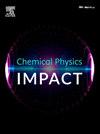新型苄基衍生物:合成及其抗菌和抗癌研究和硅研究
IF 3.8
Q2 CHEMISTRY, PHYSICAL
引用次数: 0
摘要
鉴于糖基药物的重要性,本研究重点合成了5种新型的甲基4,6- o -苄基-α- d -葡萄糖吡喃苷(2,MBDG)类似物(3-7)。体外抗菌筛选表明,这些MBDG衍生物对黑曲霉具有良好的抗真菌活性,抗菌活性中等。化合物4对5种不同菌株的MIC为0.68 ~ 2.7 mg/mL, MBC为1.35 ~ 5.4 mg/mL。在MBDG的第2位和第3位插入各种酰基,特别是(CH3(CH2)3CO-)和(CH3(CH2)4CO-),提高了抗菌效果(2)。化合物6在500 μg/mL浓度下对EAC (Ehrlich腹水癌)细胞增殖抑制率为30.17%,IC50值为852.47 μg/mL。此外,通过前沿分子轨道(FMO)和分子静电势(MEP)分析研究了新合成的mbdg的理化性质和相对反应活性。分子对接分析表明,与标准药物阿奇霉素相比,化合物4和5对枯草芽孢杆菌和黑孢杆菌的结合亲和力分别为-7.2 kcal/moL和-5.7 kcal/moL。通过MMPBSA结合自由能计算和分子动力学(MD)模拟确定了蛋白质-配体复合物的稳定性。这些发现表明化合物4和5可能是有用的抗菌药物。采用计算机ADMET法评价了mbdg的药理学和毒理学特性。本文章由计算机程序翻译,如有差异,请以英文原文为准。

Novel benzylidene derivatives: Synthesis and their antimicrobial and anticancer studies and in silico investigations
Given the importance of carbohydrate-based drugs, this study focused on the synthesis of five novel analogs (3–7) of methyl 4,6-O-benzylidene-α-D-glucopyranoside (2, MBDG). In vitro antimicrobial screening revealed that these MBDG derivatives possess promising antifungal activity against Aspergillus niger and moderate antibacterial activity. Compound 4 exhibited an MIC of 0.68–2.7 mg/mL and an MBC of 1.35–5.4 mg/mL against five different bacterial strains. The insertion of various acyl groups, particularly (CH3(CH2)3CO-) and (CH3(CH2)4CO-) at the second and third positions of MBDG (2), increased the antimicrobial effectiveness. Compound 6 was found to reduce EAC (Ehrlich ascites carcinoma) cell proliferation by 30.17% at 500 μg/mL, with an IC50 value of 852.47 μg/mL. Furthermore, frontier molecular orbital (FMO) and molecular electrostatic potential (MEP) analyses were conducted to investigate the physicochemical properties and relative reactivities of the newly synthesized MBDGs. Molecular docking analysis revealed that compounds 4 and 5 bind efficiently with binding affinities of -7.2 kcal/moL and -5.7 kcal/moL against Bacillus subtilis and A. niger, respectively, compared with the standard drug azithromycin. The stability of the protein‒ligand complexes were ascertained via MMPBSA binding free energy calculations and molecular dynamics (MD) simulations. These findings demonstrate that compounds 4 and 5 may be useful antimicrobial medications. An in silico ADMET assay was employed to evaluate the pharmacological and toxicological properties of the MBDGs.
求助全文
通过发布文献求助,成功后即可免费获取论文全文。
去求助
来源期刊

Chemical Physics Impact
Materials Science-Materials Science (miscellaneous)
CiteScore
2.60
自引率
0.00%
发文量
65
审稿时长
46 days
 求助内容:
求助内容: 应助结果提醒方式:
应助结果提醒方式:


